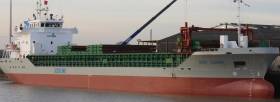Displaying items by tag: Scotline Acquire Ship
#NewcomerShip – Short-sea operator Scotline have acquired Odertal this month and renamed as Scot Leader joined the company fleet that are regular Wicklow Port callers, writes Jehan Ashmore.
The 90m general cargoship Odertal registered in Antigua and Barbuda underwent drydocking in Hull. Works included repainting in Scotline’s house colours with the funnel aptly depicting the ‘Saltire’, the distinctive national flag of Scotland also known as St Andrew's Cross.
On completion of drydocking, the newly acquired ship emerged as Scot Leader and under the UK flagged like the rest of the nine-strong company owned fleet that includes Scot Ranger. Only a week ago today, Scot Ranger of 4,500dwt similar to that of the newcomer, was monitored by Afloat.ie bound for Warrenpoint, Co. Down on Carlingford Lough having departed Wicklow Port.
Notably in August, Wicklow Port became the first of five 'Ports of Regional Significance' to transfer to local authority control under the 2013 National Ports Policy. The most easterly port in the Republic now under Wicklow County Council, has over many years specialised in timber trade imports from Scotland and Scandinavia.
Scotline Leader is registered at Inverness from where Scotline made its first shipment in 1979 bringing logs to Bremen, Germany, before moving the route to Varberg in Sweden.
Trade in packaged timber products at Wicklow Port remains to be a major cargo for Scotline, the Rochester in Kent based operator which operates liner trade routes in north-west Europe and Scandinavia. The addition of Scot Leader which has a single box hold provides a timber-fitted capacity of 6,325 cubic metres. The new entrant originally launched as Odertal in 2007 from Bodewes shipyard is currently busy rolling out a 10 ship order for Arklow Shipping.
The Scot Leader can handle 221 TEU containers. On a related note, when writing for Inshore-Ireland (Oct.2005) about Wicklow Port Company during the height of the Celtic Tiger, the port had plans for a container load-on/load off (lo-lo) terminal. Against this backdrop the port was experiencing boom times with not just timber but also plasterboard due to the demands of the construction industry.
The container facility would have been a historic first for the harbour but the project never took off the quayside. Wicklow Port has three commercial quays.
Scot Ranger's recent call took place alongside Packet Quay which is the most commonly used berth. The other berths closer to the town are the North and South Quays that line the Leitrim River before it flows into the sea.





























































